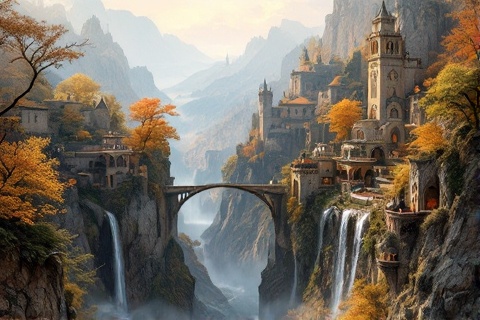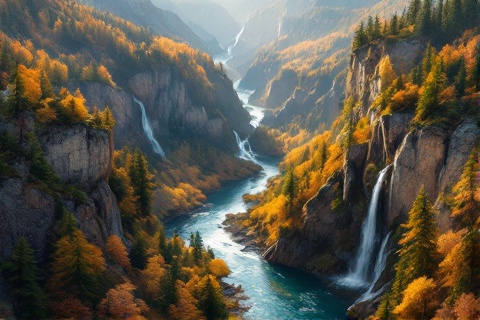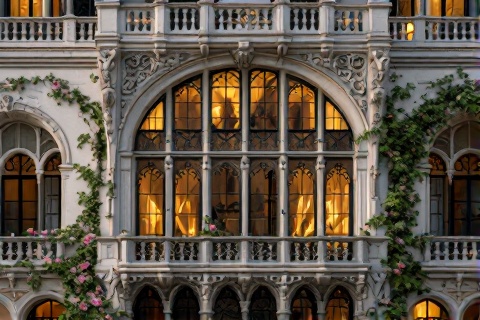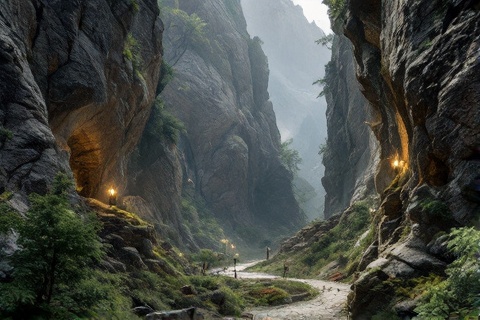
Imladris Unveiled: The Hidden Valley of Rivendell
Exploring the Sanctuary of Elrond in Tolkien's Middle-earth
The Valley's Natural Setting

Imladris, commonly known as Rivendell in the Common Speech, lies within a deeply
cloven valley in the foothills of the Misty Mountains. Founded by Elrond in the
Second Age following the destruction of
Eregion, this hidden refuge rests in a location so secluded
that even birds and beasts must search carefully to find it.
The valley's distinctive geography is shaped by the confluence of powerful
waters. The Bruinen, or Loudwater, meets its tributaries at this junction,
creating a natural fortress enhanced by the presence of these rushing waters.
The rivers' constant flow provides both protection and sustenance to the
valley's inhabitants, while their melodious sounds add to the ethereal
atmosphere of this elvish sanctuary.
The valley floor and surrounding slopes burst with an abundance of life,
showcasing the horticultural mastery of the Elves. Ancient trees,
some dating back to the Elder Days, stand as silent sentinels while carefully
cultivated gardens display a harmony of native and cultivated species. The
meadows remain eternally green, dotted with flowers that seem to capture the
very essence of starlight in their petals.
Elrond's power over the river Bruinen serves as one of Imladris's greatest
defenses. Through his mastery of Vilya, one of the Three Elven
Rings, he can command the waters to rise against
intruders, as demonstrated when he summoned the flood that swept away the
Nazgûl pursuing Frodo. This combination of natural and magical
protection has kept Imladris safe through three ages of
Middle-earth.
Architecture of the Last Homely House

The Last Homely House east of the Sea stands as a masterpiece of Elvish
architecture, its multiple levels and terraces cascading down the valley walls.
The main house follows the natural contours of the land, creating an organic
flow that makes the structure appear as if it grew from the very rock itself.
Each level offers different perspectives of the surrounding landscape, while the
terraces provide spaces for contemplation and gathering.
The building's exterior and interior spaces showcase the refined aesthetic of
Elvish craftsmanship through delicate arches that seem to float without visible
support, slender columns that reach skyward like tree trunks, and intricate
stone carvings that tell stories of ages past. These architectural elements
reflect the Elves' deep connection to both their history and the natural world,
with patterns that echo leaves, stars, and flowing water.
Massive windows pierce the walls of Imladris, allowing natural light to flood
its interior spaces throughout the day. These openings are strategically placed
to capture both sunlight and starlight, creating ever-changing patterns across
the floors and walls. The play of light through these windows transforms the
interior spaces throughout the day, maintaining a constant connection with the
outside world.
Every hall and chamber within Imladris demonstrates the Elvish principle of
living in harmony with nature. The rooms follow the natural structure of the
valley's rock formations, with corridors that wind like river paths and chambers
that open to the sky. Natural materials predominate throughout, with stone,
wood, and crystal worked with such skill that they retain their inherent beauty
while serving their architectural purpose.
Gardens and Grounds

The gardens of Imladris represent a perfect blend of natural growth and careful
cultivation, where flowers bloom in defiance of normal seasonal patterns.
Through the Elves' careful tending and perhaps the lingering power of Vilya,
roses flower even in winter, while summer brings forth blossoms whose names are
known only in the ancient tongues of the Eldar.
Throughout the valley, visitors discover countless paths winding between ancient
trees and leading to secluded grottos. These hidden spaces offer refuge for
private conversations and quiet contemplation, each designed to create a sense
of discovery and wonder. Some paths lead to unexpected viewpoints of the valley,
while others guide wanderers to peaceful clearings perfect for rest and
meditation.
The sound of water is ever-present in Imladris, flowing from elegant fountains
crafted by Elvish artisans and gathering in tranquil pools that reflect the sky
above. These water features serve both aesthetic and practical purposes,
providing drinking water while creating music that mingles with the natural
sounds of the valley.
The terraced gardens that descend toward the valley floor demonstrate the Elves'
mastery of landscape architecture. Each level features different types of plants
and designs, creating distinct environments that flow naturally into one
another. Some terraces host herb gardens used in healing, while others feature
arrangements of flowers and shrubs that create living tapestries visible from
various vantage points throughout the valley.
The Hall of Fire
The Hall of Fire stands as one of Imladris's most renowned gathering places,
where a great hearth burns continuously throughout the year. This perpetual
flame provides both warmth and light, creating an inviting atmosphere that draws
residents and guests alike to gather and share in the community of the Last
Homely House.
Within the Hall of Fire, countless tales have been shared and songs sung, from
the great epics of the Elder Days to simple tales of joy and mirth. It was here
that Bilbo often recited his verses, and where
Aragorn first heard the tale of Beren and
Lúthien. The hall serves as a living repository of
lore and legend, where the oral traditions of Middle-earth's peoples are
preserved and shared.
The hall's furnishings exemplify the Elvish preference for elegant simplicity,
with comfortable seats arranged to encourage conversation and communal
gathering. The furniture is both beautiful and functional, crafted from
materials chosen for their natural beauty rather than ornate decoration.
The architectural design of the Hall of Fire creates perfect acoustics for the
sharing of songs and stories. Sound carries clearly throughout the space without
echoing, allowing even whispered tales to reach attentive ears. The hall's
dimensions and materials were carefully chosen to enhance the natural resonance
of voices and instruments, creating an ideal environment for the performance of
the great songs and tales of Middle-earth.
Libraries and Houses of Learning

The libraries of Imladris house one of the most comprehensive collections of
lore in Middle-earth, containing books, scrolls, and records dating back to the
First Age and beyond. These archives preserve knowledge that
would otherwise be lost to time, including histories of
Númenor, tales of Beleriand, and records
of the Elder Days written in languages now forgotten by most.
Scattered throughout the house are quiet study rooms offering spectacular views
of the valley, creating perfect environments for scholarly pursuit and
contemplation. These spaces were designed to provide both inspiration and focus,
allowing scholars like Gandalf and Aragorn to delve deep
into ancient texts while surrounded by the natural beauty of Imladris.
The archives of Imladris contain detailed accounts of Middle-earth's history,
including the original witness accounts of great events and carefully preserved
genealogies of both Elven and human bloodlines. These records proved invaluable
during the War of the Ring, providing crucial information about the nature of
the One Ring and its history.
Dedicated workshops within Imladris host scribes and artists who work to
preserve and create new records and artistic works. These craftspeople maintain
the traditions of Elvish bookmaking and illustration, creating works of both
practical and artistic value. Their efforts ensure that the knowledge and
culture preserved in Imladris will endure for future generations.
Defensive Features

The main entrance to Imladris lies at the end of a narrow gorge, concealed from
casual observation and easily defensible. This natural bottleneck has helped
protect the valley through ages of conflict, allowing even a small force to
guard against much larger armies seeking to breach its defenses.
Throughout Imladris, bridges and pathways are positioned not just for
convenience but also for strategic advantage. These structures can be quickly
defended or destroyed if necessary, while providing efficient routes for the
valley's inhabitants. The placement of these passages demonstrates the careful
balance between accessibility and security that characterizes the valley's
design.
The natural cliff walls surrounding Imladris rise to impressive heights,
creating an almost impenetrable barrier against invasion. These steep faces
discourage climbing and channel any approach through easily monitored paths,
while also protecting the valley from harsh weather and providing a sense of
security to its inhabitants.
The Ford of Bruinen serves as both entrance and barrier, representing the first
line of defense for Imladris. This shallow crossing point of the river can be
controlled through Elrond's power, allowing him to deny passage to enemies while
ensuring safe crossing for friends. The ford's strategic importance was
demonstrated during the pursuit of Frodo, when the waters rose to sweep away the
Nazgûl.
Healing Houses and Gardens
The healing quarters of Imladris reflect the profound understanding of medicine
and recovery that Elrond has gathered through millennia of experience. These
peaceful rooms are designed to promote rest and healing, with every detail from
the color of the walls to the quality of light carefully considered to aid in
recovery.
The healing gardens of Imladris contain a vast array of medicinal plants, many
of which are rare or extinct elsewhere in Middle-earth. These gardens serve both
practical and educational purposes, providing necessary ingredients for healing
while also preserving knowledge of their uses. The careful cultivation of these
plants ensures a constant supply of healing herbs for both the residents of
Imladris and travelers in need.
The very air of Imladris carries healing properties, clear and fresh with the
scent of pine and flowing water. This atmospheric quality, enhanced by the
valley's unique location and perhaps by Elrond's ring Vilya, creates an
environment naturally conducive to recovery and renewal. Many who arrive weary
find their spirits lifted merely by breathing the valley's air.
Beyond physical healing, Imladris provides spaces dedicated to spiritual and
emotional recovery. These sanctuaries offer refuge for those burdened by grief
or darkness, allowing them to find peace and restoration through quiet
contemplation, guided meditation, and the gentle influence of Elvish wisdom and
music.
